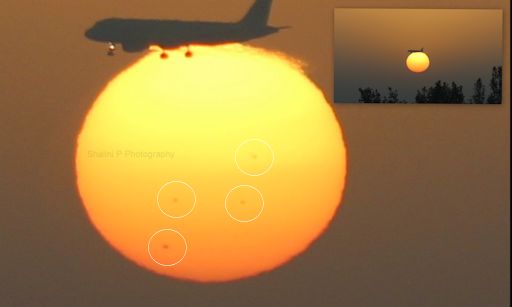SUNSPOT SUNRISE: The sunspot number is so high, it is starting to confuse photographers. Consider this story from Beijing, China, on the morning of Nov. 15th: "Beijing is usually very polluted and we often miss seeing the sun rise in the morning," says Shalini Purohit. "Today, however, the morning sky was clear and I decided to take some pictures. When I looked at the image I thought there must be come specks of dust on my lens." In fact, the lens was clean; those specks were sunspots:
When the sunspot number is high, so is the chance of flares. NOAA forecasters estimate a 50% chance of M-class flares and a 15% chance of X-flares during the next 24 hours. As Purohit's image shows, at least four of the sun's spots are facing Earth. If any eruptions do occur, they will likely be geoeffective. Solar flare alerts: text, voice

Solar wind
speed: 533.6 km/sec
density: 5.9 protons/cm3
explanation | more data
Updated: Today at 1546 UT
X-ray Solar Flares
6-hr max: C2 0901 UT Nov16
24-hr: M1 0749 UT Nov16
explanation | more data
Updated: Today at: 1500 UT
![]()
Daily Sun: 16 Nov 13
Sprawling sunspot AR1897 has a 'beta-gamma-delta' magnetic field that harbors energy for X-class solar flares. . Credit: SDO/HMI
![]()
Sunspot number: 272
What is the sunspot number?
Updated 16 Nov 2013
Spotless Days
Current Stretch: 0 days
2013 total: 0 days (0%)
2012 total: 0 days (0%)
2011 total: 2 days (<1%)
2010 total: 51 days (14%)
2009 total: 260 days (71%)
Since 2004: 821 days
Typical Solar Min: 486 days
Update 16 Nov 2013
The Radio Sun
10.7 cm flux: 178 sfu
explanation | more data
Updated 16 Nov 2013
![]()
Current Auroral Oval:
Switch to: Europe, USA, New Zealand, Antarctica
Credit: NOAA/POES
![]()
Planetary K-index
Now: Kp= 3 quiet
24-hr max: Kp= 4 unsettled
explanation | more data
Interplanetary Mag. Field
Btotal: 8.5 nT
Bz: 4.4 nT south
explanation | more data
Updated: Today at 1546 UT
![]()
Coronal Holes: 16 Nov 13
Solar wind flowing from the indicated coronal hole could reach Earth on Nov. 17-18. Credit: SDO/AIA.





